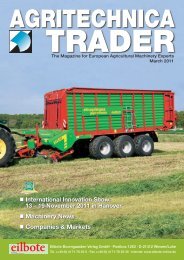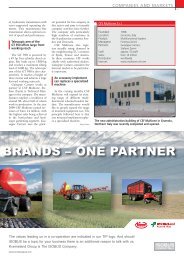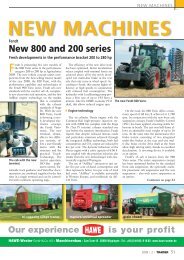Titel-Trader 2.2009.indd - Agritechnica Trader
Titel-Trader 2.2009.indd - Agritechnica Trader
Titel-Trader 2.2009.indd - Agritechnica Trader
You also want an ePaper? Increase the reach of your titles
YUMPU automatically turns print PDFs into web optimized ePapers that Google loves.
AGRITECHNICA<br />
ISOBUS for improved<br />
farm effi ciency<br />
International data communication standard presented at <strong>Agritechnica</strong><br />
Many electronics-based<br />
agricultural solutions<br />
are aimed at increasing<br />
farm effi ciency. Still, this could<br />
be further enhanced through a<br />
standardised data communications<br />
system which allows several<br />
different farming systems to<br />
work together. Not only does<br />
this improve effi ciency, it also<br />
adds fl exibility by allowing farmers<br />
to choose the exact solution<br />
that meets their needs.<br />
Having different machinery<br />
and computer functions work<br />
together requires a standardised<br />
data communication system.<br />
Without it, single electronics-based<br />
solutions may not<br />
be compatible. Enabling interconnectivity<br />
between the wide<br />
range of equipment and systems<br />
found in many farms today optimises<br />
effi ciency and productivity.<br />
A standardised ISOBUS<br />
makes this possible worldwide<br />
by integrating systems such as<br />
those used for tractors, for example<br />
sprayers, as well as farm<br />
management computers.<br />
20 TRADER | 2 | 2009<br />
The Agricultural Industry<br />
Electronics Foundation (AEF),<br />
founded by several agri-machinery<br />
associations worldwide, aims<br />
to establish such high standards<br />
in global electronics. This joint<br />
effort represents a commitment<br />
to the further development of<br />
compatible systems at an international<br />
level, which ultimately<br />
serve to help farmers worldwide<br />
achieve maximum returns<br />
through the optimal use of technical<br />
solutions.<br />
What this means for the farmer<br />
is that he is able to choose<br />
any equipment with the guarantee<br />
that it will be compatible<br />
with what he is already using.<br />
ISOBUS also extends the<br />
possibilities of precision farming<br />
through ‘more intelligent’<br />
functions and GPS data integration.<br />
In addition, ISOBUS<br />
automates machinery and implements<br />
settings for different<br />
operations, thus combining the<br />
tractor, mounted implements<br />
and terminal into a system with<br />
the qualities of a self-propelled<br />
machine. More here: www.isobus.net/isobus_E/<br />
At <strong>Agritechnica</strong>, the ISOBUS<br />
standard is presented under the<br />
theme “ISOBUS LIVE”. Proofing<br />
engineers and experts from<br />
the DLG are available together<br />
with representatives from the<br />
AEF in hall 17 D43a to explain<br />
the latest technologies and developments<br />
through the entire<br />
duration of the exhibition. Additionally,<br />
several forums (some<br />
in English) address future ISO-<br />
BUS developments and their<br />
practical applicability. Forum 2<br />
entitled “Technology and Management”<br />
deals specifi cally with<br />
ISOBUS issues. View the Technical<br />
programme at www.agritechnica.com<br />
for further details.<br />
Testing ISOBUS systems<br />
DLG’s Test Centre has the<br />
capability to accommodate the<br />
programming and implementation<br />
of new software versions<br />
and systems.<br />
ISOBUS systems applied in<br />
agriculture are subjected to simulated<br />
and real fi eld tests. The<br />
tests conducted conform to the<br />
current guidelines of the ISO<br />
standard 11783.<br />
Bus system tests require complex<br />
proofi ng methods covering<br />
three key areas:<br />
• Physical layer test<br />
• Test data layer<br />
• Communications protocols<br />
The centre also offers companies<br />
a range of compatibility<br />
and functionality tests designed<br />
to evaluate agricultural components<br />
and systems. The “plough<br />
test” for example is designed to<br />
test and optimise system compatibility<br />
between several manufacturers.<br />
In addition, a compatibility<br />
test shows up possible<br />
problems which can be analysed<br />
and solved.<br />
Hardware and software developers<br />
will fi nd the centre a<br />
perfect place to meet up, share<br />
knowledge and exchange ideas.<br />
More information is available in<br />
hall 17 D43.






